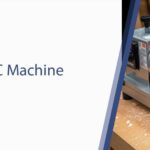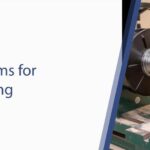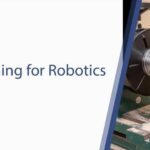The CNC router is one of the most versatile and transformative tools in modern making. From the intricate carvings on custom cabinetry and the bold lettering of commercial signs to precision-cut industrial components and artistic 3D reliefs, these machines have democratized digital fabrication.
But behind every perfectly cut piece of plywood, every smoothly contoured piece of foam, and every engraved piece of plastic is a powerful suite of software that translates a creative vision into physical reality.
Understanding the programming software for a CNC router is the key to unlocking its full potential.
This software ecosystem is where designs are born, cutting strategies are devised, and the final machine instructions are generated. It’s a journey from pixels on a screen to the finished product in your hands.
As a developer of the high-performance CNC controllers that drive these machines, Radonix knows that the best designs deserve the best execution.
In this ultimate guide, we will navigate the entire CNC router software workflow, explore the industry-standard programs, and explain why the final control software is the most critical element for achieving a high-quality finish.
The CNC Router Software Workflow: A Three-Step Journey
For newcomers, “CNC software” can seem like a monolithic term, but it’s actually a straightforward three-step process.
Each step utilizes a different type of software to move your project from concept to creation.
- Design (CAD – Computer-Aided Design): This is the creative stage. It’s where you create the 2D vectors (lines, curves, and shapes) or the 3D model of what you want to cut. This is the “what.”
- Toolpath Generation (CAM – Computer-Aided Manufacturing): This is the strategic stage. The CAM software takes your design and generates the cutting paths for the router bit to follow. It determines the “how,” “where,” and “how fast” of the cutting process. This is the “how.”
- Control (Machine Interface): This is the execution stage. The control software takes the instructions from the CAM stage, allows the operator to set up the machine, and sends the real-time electrical signals to the router’s motors to perform the actual cutting. This is the “do it.”
Many modern router software suites combine the CAD and CAM stages into a single, integrated program, streamlining the workflow significantly.
Part 1: Design & Vector Creation (The CAD Stage)
Unlike engineering-focused CNC milling which often starts with complex 3D solid models, many CNC router projects begin with simple 2D vectors.
What are Vectors?
Vectors are mathematical lines, arcs, and curves that form the outlines of a design.
Because they are based on mathematical formulas, they can be scaled to any size without losing quality (unlike pixel-based images like JPEGs).
This makes them perfect for CNC work.
Popular Software for CNC Router Design:
- All-in-One CAD/CAM Suites (The Industry Standard)
These programs are the workhorses of the CNC router world because they seamlessly integrate both design and toolpath generation.
- Vectric Software (VCarve and Aspire): If there is one name synonymous with professional and high-end hobbyist routing, it’s Vectric.
- VCarve (Pro & Desktop): This is arguably the most popular CNC router software on the market. It excels at 2.5D work, which includes profile cutting, pocketing, drilling, and its namesake, V-Carving. V-carving uses a V-shaped bit to create beautiful, sharp-cornered text and intricate designs that appear hand-carved. VCarve Pro also includes powerful features like nesting (see below).
- Aspire: This is Vectric’s flagship product. It includes all the features of VCarve Pro, but adds powerful tools for creating and editing true 3D relief models. Users can sculpt 3D shapes, import 3D models, and combine them to create complex artistic carvings, reliefs, and textures.
- Autodesk Fusion 360: For users coming from an engineering or product design background, Fusion 360 is a powerhouse. It offers true solid modeling CAD, making it ideal for designing mechanical parts or complex assemblies that need to be cut on a router. Its integrated CAM is extremely powerful, though it can have a steeper learning curve than Vectric for purely artistic work.
- Beginner-Friendly and Web-Based Software
- Easel (by Inventables): Easel is a free, web-based software that simplifies the entire process. It combines basic design and toolpath generation in one easy-to-use interface. It’s an excellent starting point for new hobbyists to learn the fundamentals before moving on to more powerful software.
- Traditional Graphic Design Software
Many router users are also graphic designers. It’s common for a design to start in a familiar program like Adobe Illustrator or CorelDRAW.
The design can then be exported as a vector file format (like .SVG, .AI, .EPS, or .DXF) and imported into a dedicated CAM program like VCarve for toolpath creation.
Part 2: Toolpath Generation (The CAM Stage)
This is where the magic happens. The CAM software takes your vector design and you, the programmer, make the strategic decisions to turn it into G-code.
Core Router-Specific Toolpath Strategies
- 2D Profile Toolpath: This is used to cut a shape out of a material. A key feature here is adding “tabs”—small, thin pieces of material that are left uncut to hold the part in place and prevent it from flying off the machine as the cut is completed.
- Pocketing Toolpath: This clears out all the material inside a closed vector shape to a specific depth.
- V-Carving Toolpath: As mentioned, this uses a V-bit. The software automatically calculates the path of the bit, allowing it to raise and lower in corners to create a sharp, chiseled look. It’s the standard for high-quality sign making.
- 3D Roughing & Finishing: For 3D models (from Aspire or Fusion 360), this is a two-step process.
- 3D Roughing: A larger, flat-bottomed bit (an end mill) is used to rapidly clear away the bulk of the waste material.
- 3D Finishing: A smaller, round-tipped bit (a ball-nose mill) is then used to go back and forth over the entire model in tiny step-overs, creating the final smooth, detailed 3D surface.
A Key Industrial Feature: Nesting
For businesses that need to cut many different parts from large sheets of material (e.g., a cabinet maker), nesting is an essential feature.
Nesting software automatically analyzes all the parts in a job and arranges (nests) them on the sheet in the most efficient way possible, minimizing material waste and saving significant amounts of money.
This feature is available in software like VCarve Pro and Aspire.
The Final Translation: The Post-Processor
Once all toolpaths are created and simulated, the CAM software uses a post-processor to translate them into the final G-code file.
The post-processor is configured specifically for the target control software.
For example, you would select the “Radonix CNC” post-processor to ensure the G-code is perfectly formatted for your Radonix controller.
Part 3: The Control Software – Bringing Your Design to Life
You can have the most beautiful design from Aspire and the most optimized G-code, but the final quality of your project—the smoothness of its curves, the sharpness of its edges—is determined entirely by the control software.
This software is the real-time interface between the G-code file and the machine’s motors. It’s the “do it” stage, and its performance is paramount.
The Problem with Poor Motion Control
A basic controller simply reads one line of G-code, moves, stops, reads the next line, moves, and stops again.
When cutting a curve made of many tiny straight lines, this “start-stop” motion results in jerky movements, visible facets on your curves, and burn marks.
It puts unnecessary stress on the machine and produces a low-quality finish.
Smooth Motion, Perfect Finish: The Radonix Controller Difference
This is where a high-performance, PC-based controller like a Radonix system truly shines, especially for CNC routers.
- Advanced Motion Planning (Look-Ahead): This is the most important feature for router quality. Radonix controllers don’t just read one line at a time. They read hundreds or thousands of lines of G-code in advance (look-ahead) and analyze the path. This allows the controller to plan a smooth, continuous trajectory, intelligently accelerating and decelerating through curves without ever stopping. This feature, often called “Constant Velocity” mode, is the secret to cutting perfectly smooth arcs and circles at high speed.
- Intuitive, User-Friendly Interface: The Radonix software platform runs on a PC, offering a large, graphical interface that is easy for operators of all skill levels to understand. Setting your X, Y, and Z zero points, visualizing the toolpath before you cut, and monitoring the job’s progress are simple and intuitive.
- Robust and Reliable Performance: Our controllers are designed to provide the stable, jitter-free signal that motors need for smooth operation. This reliability is crucial for long 3D carving jobs that can run for many hours.
- Universal Compatibility: A Radonix controller is a perfect brain for any new or existing CNC router. It is designed to flawlessly execute standard G-code from any major CAM package, including the entire Vectric suite, Fusion 360, and more. This makes it a seamless upgrade for any machine running on older or less capable control software.
A Real-World Workflow: Creating a V-Carved Wooden Sign
- Design (in Vectric VCarve): You start a new job, defining the size of your piece of wood. You use the text tools to write “WELCOME” and use the drawing tools to create a decorative border.
- Toolpath (in Vectric VCarve): You select the “WELCOME” text and apply a V-Carve toolpath, choosing a 90-degree V-bit. You select the outer border and apply a Profile toolpath, choosing a 1/4″ end mill and adding four tabs to hold the sign in place. You preview the toolpaths in the 3D simulation.
- Post-Process (in Vectric VCarve): Everything looks perfect. You save the toolpaths using the “Radonix CNC (inch)” post-processor. This creates a single G-code file named WELCOME_SIGN.nc.
- Control (with Radonix): You load the .nc file into the Radonix control software. On the machine, you clamp your wood down, set your X and Y zero to the corner of the piece, and use a Z-probe to automatically set the tool height.
- Execution (with Radonix): You press “Cycle Start.” The Radonix controller’s advanced motion planning takes over. It executes the V-carve toolpath with fluid, continuous motion, creating sharp, clean letters. It then flawlessly cuts the outer profile, leaving the tabs intact. The result is a professional-quality sign, created with smoothness and precision that a basic controller simply cannot match.
Conclusion
The software ecosystem for CNC routers is incredibly powerful, offering tools that can take any creative idea and turn it into a detailed cutting plan.
Software like Vectric Aspire and VCarve puts amazing design and toolpath capabilities at your fingertips.
But all of that creative potential can be wasted in the final step of execution.
The ultimate quality of your work—the smoothness of the finish, the precision of the details, the sharpness of the carving—is not determined by the G-code file itself, but by the controller’s ability to interpret and execute that file with intelligence and fluid motion.
Don’t let a jerky, underperforming controller compromise your creative vision.
Invest in a control system that has the advanced motion planning necessary to bring your designs to life with the quality they deserve.
Your creativity knows no bounds. Your machine’s finish shouldn’t either. Contact Radonix today to learn how our advanced PC-based control systems can bring unparalleled smoothness, precision, and quality to your CNC router.
Contact Us:
- E-Mail: info@radonix.com
- Phone: +90 (553) 920 5500








